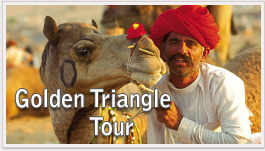Sawai Madhopur Tour Packages
Unveil the past!!
The name Ranthambhore is derived from two hills in the area, Ran and Thanbhor. Another version says that Ranthambhore was once called Rana Stambhapura or City of the Pillars of War. Ranthambhore has been a witness to the rise and fall of many rulers and a series of battle scenes. In the 13th century A.D., Govinda, the grandson of Prithviraj Chauhan took over the reign of the land. Later, his successor Vagbhatta beautified the city and built a noteworthy temple at Jhain. In the middle of 15th century A.D., Rana Kumbha captured the fort and gifted it to his son to be occupied later by the Hada Rajputs of Bundi and Mughal Emperors Akbar and Aurangazeb. Mughal emperor Shah Alam gifted it to Maharaja Sawai Madho Singh 1 of Jaipur in 1754 and since then it was mainted as trhe hunting preserve of the Maharaja Sawai Madho Singh queen Elizabeth II and the Duke of Edinburgh were part of the royal part of hunting parties who stayed here.
 |
||
| Tiger | ||
Wildlife at Ranthambhore
Ranthambhore is rich in migratory, water, and woodland birds. Ranthambhore provides shelter to an amazing variety of plants and animals including about 300 plant species, over 50 aquatic plant species and more than a 100 species of herbs, climbers and grass. It is also home to over 270 species of birds and nearly 30 different species of mammals. While at Sawai Madhopur you may stay at the lodge and move to the National Park and spot Leopards, Wild Boars, Crocodiles, Langurs, Sloth Bears, Jungle Cats, Blue Bulls, Chinkaras and Hyenas, Sambhar, the Asiatic Deer Doves, Partridges, Storks, Flycatchers, Kingfishers, and Hawk Eagles. During winters migratory birds like Greylag Geese, Ruddy Shel ducks and Pintails may also be spotted.
EXCURSIONS:
Kameshwar Mahadev - Mini Khajuraho (40 km): This is a Post-Gupta period temple which is definitely 1200 year old example of art and culture. This temple dedicated to Lord Shiva has hundreds of couples in sexual carvings like those in Khajuraho. Every fourteenth day of Hindu months, thre is a fair held at the temple.
Surwal Lake (20 km): A shallow seasonal lake, situated between acres of agricultural fields, which usually dries out by April-May is home to a large number of different kinds of migratory birds during winters. Painted Storks, Flamingoes, Spoonbills, Sarus Cranes, Greylag Geese amongst others can be seen in large numbers in Surwal between the months of November and March. During this season, the best time to see birds is very early in the morning. Serious Bird watchers should be at the lake before sunrise.
Bhuri Pahadi Gaon (25 km): In this town is confluence of two rivers. There is a desert stretch of about 6 sq km. Thousands of flamingos migrate to this region every year in October - November and stay over to next year, March.
Devpura (25 km): Where Black Bucks abound, is not far from Surwal. Here one often sees small herds of Black Bucks grazing in farmlands. Interestingly, Black Bucks are almost never seen inside the Ranthambhore National Park. This could be because Black Bucks prefer open spaces to jungles.
Rameshwaram Ghat (70 km): Which lies at the confluence of rivers Chambal and Banas, is home for large number of migratory birds, crocodiles, alligators, the endangered river dolphins (which are very rare) and many other animal species. A group of ancient temples also located at the ghat.
Since these ghats are beyond the Mansarovar Lake and Khandar Fort one can visit both these places in the same trip.
Pali Ghat (40 km): Situated on the banks of the river Chambal, on the border of Rajasthan and Madhya Pradesh states. This stretch of the river is officially a crocodile sanctuary and is particularly beautiful during full moon nights.
SHOPPING:
The region is famous for "Khas" perfumes and other objects made of "Khas" including fans, small boxes, caps, etc.
How to get there!
Air:The nearest airport is Jaipur which is just 145 kms away.
Rail: Ranthambhore National Park is 11 kms away from Sawai Madhopur railway station. It is on the main Delhi-Bombay railway line and major trains stop here.
Road: A good network of buses connects Sawai Madhopur, the nearest town from Ranthambhore to all the major cities within the state of Rajasthan.
When to visit
The best time to visit Ranthambhore National Park is during the months of October to March and April to June. Jeeps can be booked up to five months in advance and even a day earlier. The Park is closed from end June to end September.
Jaipur
Mr.Gaurav Sharma (Tour Manager)
G-2 Aggarwal Farm Mansarovar Jaipur
Mobile No :- +91-8094315943 Customer Care 24 Hour Support 9509025926
Udaipur
Mr.Shantanu (Tour Manager)76, Ekling Nagar, Goverdhan Vilas, Udaipur - (Rajasthan) India.
Mobile No :- +91-9521480383 Customer Care 24 Hour Support 9509025926
Email Id :[email protected]
Jaisalmer
Mr.Ravi (Tour Manager)Jaisalmer - (Rajasthan) India.
Mobile No :- +91-8094315943 Customer Care 24 Hour Support 9509025926
Email Id :[email protected]
Bikaner
Mr.Kamal (Tour Manager)Bikaner - (Rajasthan) India.
Mobile No :- +91-9971279722 Customer Care 24 Hour Support 9509025926
Email Id :[email protected]

